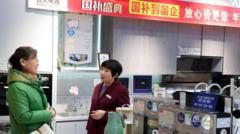In a strategic move to rejuvenate its economy, the Chinese government has broadened its trade-in program to include a range of kitchen appliances, such as microwave ovens, dishwashers, rice cookers, and water purifiers. This initiative allows consumers to trade in their old appliances in exchange for discounts of up to 20% on new goods. Previously, the trade-in program included popular electronics like televisions, smartphones, and vehicles, as part of a concerted effort to counteract the impacts of weak consumer demand and an ongoing property crisis that has plagued the world's second-largest economy.
This year, officials have allocated 81 billion yuan (approximately $11 billion) specifically for consumer goods within the trade-in scheme, which commenced in March. The National Development and Reform Commission, China's top economic planning body, has reported visible positive effects as a response to these initiatives, claiming an increase in sales of larger ticket items, including home appliances and automobiles.
However, opinions among economists vary regarding the effectiveness of these measures. Dan Wang, an economist based in China, argues that the trade-in program may fall short in stimulating broader consumer spending, stating, "The measure is far from being enough to boost consumption." Similarly, Harry Murphy Cruise, head of China economics at Moody's Analytics, notes that while the program has increased sales of specific products, it has not substantially lifted overall consumer expenditure.
As China confronts significant headwinds in its export sector, recent government conferences have emphasized the urgent need for "vigorous" actions to promote domestic consumer spending. This directive has become increasingly pressing as the nation prepares to release its economic growth projections for 2024, which the government anticipates will reach approximately 5%. Furthermore, external pressures, such as the potential for higher tariffs on Chinese goods under a new U.S. administration, add to the urgency for China to take proactive measures to bolster its economy.



















